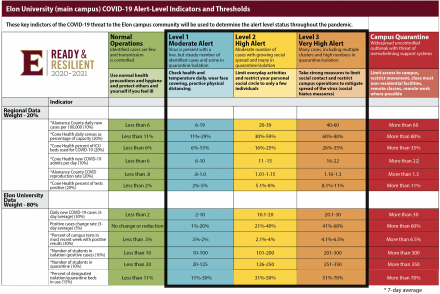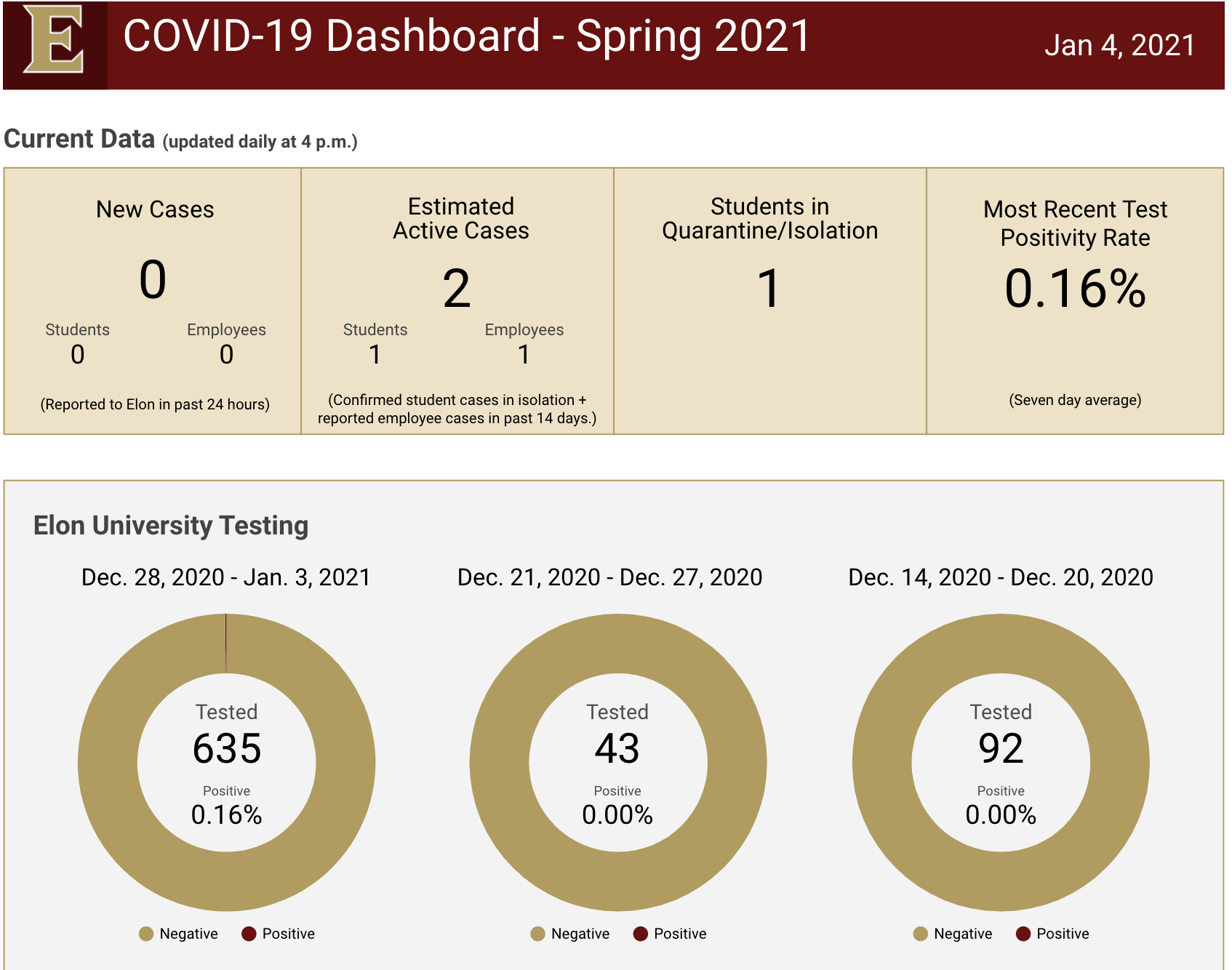Enhanced tools will improve university’s information-sharing in Winter Term and Spring Semester 2021
The COVID-19 Dashboard
Elon’s new Dashboard, which is part of the Ready & Resilient website, highlights information about the daily COVID-19 testing that will take place in Alumni Gym through the end of Spring Semester. The entire student body will be tested regularly for the virus and the Dashboard will provide a daily measure of the positivity rate in the testing system.
“Our Winter Term and Spring Semester strategy is centered around community testing,” said Jeff Stein, who heads the university’s Ready & Resilient committee. “By identifying cases early, we can more effectively use quarantine to isolate positive cases and slow the spread on campus. The new Dashboard will allow everyone to keep tabs on the presence of the virus in our daily testing samples and also allow us to move more quickly with stronger mitigation steps if we start to see increased spread of the virus.”
The new Dashboard also includes the most vital information included in the previous version, including the number of daily new cases, the daily estimate of active cases and the number of students in isolation and quarantine. In addition, the new Dashboard includes a count of the number of daily new cases in Alamance County and in the state of North Carolina. A link on the page allows access to all the archived data shared from the Fall Semester Dashboard.
Elon’s fall semester COVID-19 Dashboard was ranked among the nation’s best by the “We Rate COVID Dashboards” website, earning an A- score. That tied Elon’s Dashboard for the top ranking in North Carolina. Nationally, only 72 school dashboards received a grade of A- or higher.
Elon’s COVID-19 Alert System
Based on experience in the fall, Elon has updated its campus alert system, which is based on 12 key measures of the COVID-19 impact on the campus community and surrounding region.

The new COVID-19 Alert System will have three alert levels instead of four, providing a simplified assessment of the current threat:
- Level 1 (blue) – Moderate Alert: Virus is present with a low, but steady number of identified cases and some in quarantine/isolation.
- Level 2 (yellow) – High Alert: Moderate number of cases with growing social spread and many in quarantine/isolation.
- Level 3 (orange) – Very High Alert: Many cases, including multiple clusters and high numbers in quarantine/isolation.
When the pandemic threat eventually diminishes, Elon will be able to drop from Level 1 – Moderate Alert to a level called “New Normal” (green), where identified cases are few and transmission is controlled.
If the pandemic spread becomes so severe that it extends beyond the data limits of Level 3 – Very High Alert, Elon would move to a level called “Campus Quarantine” (red), which is described as a widespread, uncontrolled outbreak that threatens to overwhelm the university’s support systems. In that extreme situation, Elon would take steps to strictly limit personal interactions and exposures until the virus spread is reduced.
 The data model for the new Alert System includes regional public health data gathered from the Alamance County Health Department and Cone Health Systems. There are also new indicators in the campus data model that measure the number of daily new cases, the rate of change in the case count and the number of students who have tested positive and are in isolation.
The data model for the new Alert System includes regional public health data gathered from the Alamance County Health Department and Cone Health Systems. There are also new indicators in the campus data model that measure the number of daily new cases, the rate of change in the case count and the number of students who have tested positive and are in isolation.
“We used the extensive data we tracked during Fall Semester to evaluate and scenario test our model, creating an enhanced version that is more sensitive to the factors that matter most to our community and the operations of the university,” said Executive Vice President Steven House. “The Alert System provides an objective, evidence-based and easy-to-understand measure of the current pandemic situation at Elon and in the surrounding region.”



